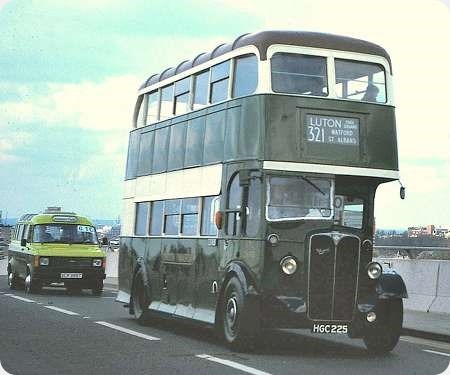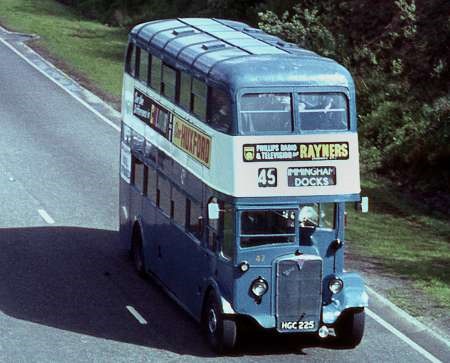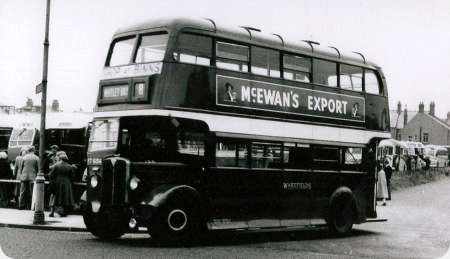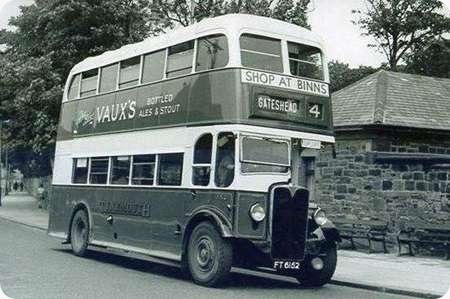London Transport – AEC Regent II – HGC 225 – STL2692
London Transport
1946
AEC Regent II
Weymann H30/26R
HGC 225 is an AEC Regent II with Weymann H56R body, and it dates from 1946. It wears Country Area green in this view, and the fleet number STL2692. Allowing for the London method of bus overhauls, how many chassis and bodies have worn this fleet number over the years? It is on Itchen Bridge, while taking part in the Southampton city transport centenary rally on 6 May 1979.
Photograph and Copy contributed by Pete Davies
19/03/17 – 10:49
"How many chassis and bodies have worn this fleet number over the years?" The answer is, just this one. These post war STL Regents didn’t last long enough with LT to pass through the Aldenham works, which only became fully operational in 1956. These buses were sold off by LT in 1955 as deliveries of the RT type became an embarrassment to the point where many new ones, together with others of the RTL class, were put straight into store upon receipt from the manufacturers. Some of these light STLs were used in 1954 on the 327 route at Hertford which traversed a weak bridge, but they were replaced in the following year by "pre war" (actually wartime) RTs which were less heavy than their post war cousins. This allowed the entire class of post war STLs to be sold to the dealer North of Leeds in July/August 1955. They soon found new owners with Dundee, Grimsby and Widnes corporations where they gave sterling service for upwards of six more years. STL 2692 went to Grimsby who got twelve years out of it before withdrawing it early in 1968.
Roger Cox
21/03/17 – 06:19
Thanks, Roger!
Pete Davies
21/03/17 – 06:20
Roger, do you happen to know if one of the municipalities you mention, perhaps Grimsby, changed the gearboxes in their examples from crash to pre-select?
I’m sure I’ve read it somewhere!
Chris Barker
21/03/17 – 08:45
Chris B – I hadn’t heard of this procedure, but if it did take place in Grimsby you have to wonder why go to such expense in a town which I assume is "as flat as a pancake" and driving a bus with a traditional transmission should surely present no problems.
Chris Youhill
21/03/17 – 15:55
Chris and Chris – I can find no record of any of these former LT STLs undergoing a gearbox change from crash to preselector, but, if true, the most likely candidate amongst the subsequent owners must surely be Dundee which had a fleet of Daimlers and AEC Regent III at that time. Do we have a Dundee expert on OBP? The Grimsby situation should be easily determined by an examination of HGC 225 itself.
Roger Cox
22/03/17 – 06:08
One of my wife’s friends lives in Grimsby. I’ll check and find out in respect of the pancakes . . .
Wife’s friend has been consulted. Grimsby is largely flat with bumps, but Cleethorpes is generally hilly with flat bits.
Pete Davies
22/03/17 – 06:10
I think I travelled on all of Grimsby’s ex-STLs (nos. 42-47 of which HGC225 was 47. 43 was HGC222 and 46 HGC219 – don’t know the others). I am sure that none were changed to pre-selectors. However there were four (I think) ex-Sheffield Regents – nos. 41 and 48-50 (?) with registrations in the KWE250 series. These had more or less identical Weymann bodies, and were pre-selectors from new. They were visually identifiable by the deeper windscreen. I’m away from home at the moment, so this is all from memory plus one or two snippets I have filed on here!
And then I realised…one of the Sheffield transfers featured in David Careless’s post in June 2013, and I responded at the time thus : "The transfers became Grimsby-Cleethorpes Transport numbers 41 (KWE 258), 48 (KWE 251), 49 (KWE 252) and 50 (KWE 254). The intervening numbers 42-47 were occupied by similarly Weymann-bodied Regent IIs ex London Transport (HGC 233, 222, 227, 228, 219 and 225 respectively)."
Stephen Ford
22/03/17 – 06:11
As a one-tome Grimbarian, I remember STL2692 as Grimsby No. 47, bought in 1955 with five other STLs to replace trolleybuses on the 10 route. Dundee was the only buyer of this batch of STLs to convert them to preselector gearboxes. HGC 225 served her initial Grimsby years in a crimson lake and cream livery, after the 1957 combination of the Grimsby and Cleethorpes operations, her colours were various permutations of blue and cream.
Mark Evans
12/01/19 – 08:25
As conjectured earlier, it was for the Dundee tram-replacement fleet that some of these London Transport Regent II were converted to pre-selector transmission. A Buses Extra article detailed the changes. I believe all the gearboxes were reconditioned, previously fitted to pre-war Dundee buses in process of withdrawal.
Stephen Allcroft
15/01/19 – 06:55
Thanks, Stephen A for the information, so it was Dundee who swapped the gearboxes for pre-selectors. I understand the post-war O661 Regent II was not offered with such a gearbox but the pre-war model (just Regent, not Regent I) was. I believe the gear selection was by means of a conventional type gear stick which rose from the floor rather than a steering column mounted unit although I’m not sure if this was universal.
Stephen says the gearboxes were reconditioned units salvaged from pre-war buses. It would be interesting to know which method of selection was employed, whichever it was, it made Dundee’s conversions unique as Regent IIs.
Chris Barker
16/01/19 – 07:19
My recollection of all the London Transport pre-war pre-selective buses (I regard the first RT’s as being Wartime) I travelled on as having conventional floor-mounted gearlevers.
I never came across a pre-war Daimler CO bus, but imagine that they would have had the simpler type of steering column lever which the CW types did in the war.
Chris Hebbron
18/01/19 – 06:34
My CO bus has the same lever set-up as CW
Roger Burdett
19/01/19 – 06:24
Thx, Roger B.
"Why change something so simple?" might well have been Daimler’s attitude and it certainly continued with their CV’s.
I had a neighbour when I lived at Morden, in Daimlerland, who’d worked both at both Putney and Merton Garages and felt that Daimler’s simple gearchange was preferable to the RT’s one.
Chris Hebbron
20/01/19 – 06:57
The later Daimler CVs (e.g. Derby Corporation’s fleet of CVG6s and no doubt many others) had an H-gate selector, similar to the AEC set-up, on the left side of the steering column (as opposed to the earlier quadrant type selector mounted on the right).
Stephen Ford
20/01/19 – 06:58
The quadrant type of gear selector used on Daimler’s CO, CW and early CV series was the same as on Daimler cars. The CV changed to the AEC type around 1953-5.
Peter Williamson
21/01/19 – 07:12
The preselector version of the Guy Arab had a floor mounted gear lever; Guy built its own preselector gearbox.
Roger Cox
24/08/22 – 06:36
I remember these 10 STLs arriving in Dundee country area green along with 30 Cravens-bodied RTs for tram replacement. The RTs with roofbox route number displays were instantly recognisable and were known locally as ‘London Buses’. Their moquette upholstery in place of the leather on the indigenous buses was also a recognition point once you were aboard. But the STLs looked so similar to the home-grown variety that none of my schoolmates would believe me that they were ex-LT. Their HGC series registrations made it obvious, but that convinced no-one! Very frustrating.
George
26/08/22 – 05:57
My only experience and sight of one was on Epsom Day in about 1950/51, when I took a ride back to Morden on one. It was the newest bus I saw that day, among all the other almost forgotten museum pieces raked out from dusty corners of garages. And a long way from its home garage in Hertfordshire!
It was also the only AEC I travelled on with this Weymann’s bodywork: the others all being Leylands.
Chris Hebbron
29/08/22 – 06:30
A caption in ABC London Transport Buses either 1961 or 1962 (I’m not sure but it was at the time when only a few trolleybuses were still in service) stated that London Transport took delivery of provincial Regents and for convenience designated them as STL’s. Maybe a reader still has copy of the book and could give more information.
Andy Hemming
25/09/22 – 06:35
Here is a shot taken on an HCVC Brighton Rally in the early 1970s of HGC 225 as No.47 in the livery of Grimsby-Cleethorpes Joint Transport Committee.
Roger Cox
29/09/22 – 06:09
Thanks for that, Roger. I wonder if she’s still around. That’s a strange roof layout – anyone know the reason for it?
Chris Hebbron
30/09/22 – 05:43
I know NGT had some of these, three I think, and NGT’s depot at Percy Main had 29.
That was out of a fleet of 105 vehicles, which included 12 coaches, and 6 single deckers, so over a third of the D/D fleet.
They were all delivered between 1945 & 1948, and were withdrawn between 1958 & 1960.
They all had 0661 engines, and all had crash boxes.
Ronnie Hoye
30/09/22 – 05:49
Chris H, I may be wrong but I believe the strange roof layout, not normally seen, was simply because the framework was on the outside of the single skin roof. I have vague recollections of riding on Midland General’s Weymann bodied Regent IIIs and remember seeing the exposed framework of the side panels from the interior. I’m not saying the bodies were meant to be lightweight at all but I’m pretty sure most of the panelling was single skinned.
Chris Barker
01/10/22 – 05:32
Sorry about the typo in my post chaps and chaperones.
It should have been NCT (Newcastle) had three and not NGT written twice.
Re the unusual roof.
The 29 in the Tynemouth & Wakefields fleet at Percy Main came in two batches. If memory serves, the first were the same as the one in the photo, with the frame on the outside, but the next batch (two years on) were double skinned.
This was just after the war, and my feeling is that he exposed frame may have been due to material shortages rather than weight saving.
Ronnie Hoye
Quick links to the - Comments Page - Contact Page - Home Page




